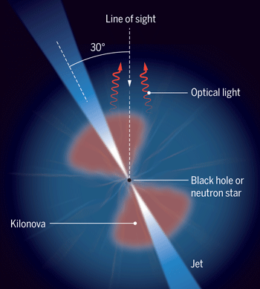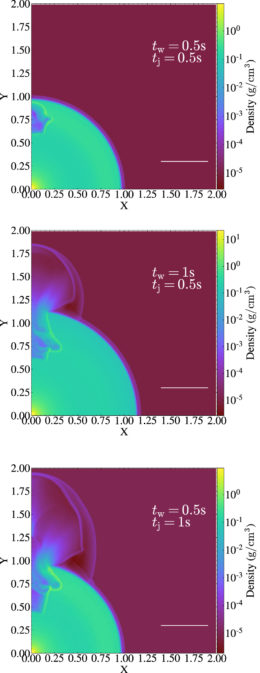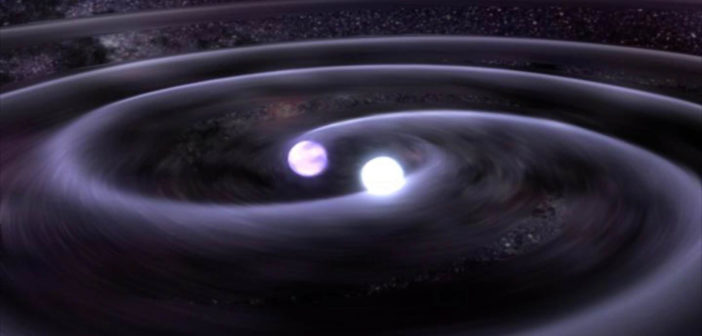The binary neutron star merger that produced GW170817 was also the source of a gamma-ray burst, which was unexpectedly faint. However, it turned out that this burst was not less energetic than average; rather, the jet that produced it had an unusual structure. So what caused the jet associated with GW170817 to look like it did?

A diagram showing the electromagnetic emissions arising from the binary neutron star merger that produced GW170817. The central jet that produced the GRB is offset from the line of sight by 30 degrees. [C. Bickel/Science]
Jet Setting Out of a Merger
The environment of a binary neutron star merger is a turbulent, energetic place. The merging objects can produce powerful winds and shed large amounts of mass, and the actual merger results in strong emission across the entire electromagnetic spectrum. The electromagnetic signal from the gravitational wave event GW170817 included the relatively short gamma-ray burst (GRB) 170817A, which turned out to be much fainter — and thus less energetic — than expected.
Some astronomers suggested that GRB 170817A belonged to a class of GRBs that were simply intrinsically less energetic, but others proposed that GRB 170817A was a typical short GRB — complete with polar jets launched after the collision — that was oriented off of our line of sight. Further study has borne out the latter prediction, but it has also shown that the jets associated with GRB 170817A have a somewhat unusual structure, especially toward their outer edges. What could cause this deviation from the norm?
To probe this question, a group of researchers led by Ariadna Murguia-Berthier (University of California, Santa Cruz/University of Copenhagen, Denmark) ran simulations of the winds and central jets involved in neutron star mergers to see how the structure of jets is influenced by their environments.

Simulations of jets that were (top to bottom) choked, marginally successful, and successful. The parameter tw is the time the winds are active and tj is the time the central engine is active. [Adapted from Murguia-Berthier et al. 2021]
Breaking Free of Winds
There are several parameters to consider while modeling how a jet would move through a merger environment. Notably, it takes a finite amount of time for the merger remnant to collapse into (most probably) a black hole with an accretion disk. The collapse triggers the jet that would produce a short GRB. The surrounding winds are dependent on this collapse time, and their density could potentially snuff out the jet, preventing it from producing a short GRB. Murguia-Berthier and collaborators focused on how the jet would be affected by these winds and disk outflows.
A jet needs time to gather enough strength to break through the surrounding winds, so the central engine that powers the jet needs to stay active till the jet is strong enough. This balance between jet strength and wind strength plays a large role in whether a jet is successful in punching out of the merger environment and forming a short GRB. Additionally, while the jet is gathering strength and making headway into the winds, extra energy is deposited into a “cocoon” around the jet. This energy cocoon evolves based on its environment and can also impact the structure of the jet.
Merging with Observations
Murguia-Berthier and collaborators explored mergers with a variety of different parameters, but the parameters associated with GW170817 were of particular interest. The kilonova that accompanied the merger and the delay between the gravitational-wave signal and the GRB helped narrow down viable scenarios for the formation of this observed explosion. With their simulations, Murguia-Berthier and collaborators found that the time it took for the merger remnant to collapse into a black hole was between 1 and 1.7 seconds. Excitingly, this range agrees with many values from previous studies that used completely different approaches to estimate the collapse time!
Murguia-Berthier and collaborators cautioned readers that the simulations could not cover every physical scenario. However, this work is a demonstration of how simulations can be used with observational constraints to better explain the outcome of neutron star mergers.
Citation
“The Fate of the Merger Remnant in GW170817 and Its Imprint on the Jet Structure,” Ariadna Murguia-Berthier et al 2021 ApJ 908 152. doi:10.3847/1538-4357/abd08e
